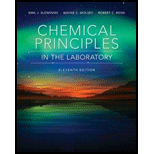
Concept explainers
You are given a colorless unknown solution that contains one of the following salts:
Want to see the full answer?
Check out a sample textbook solution
Chapter 12 Solutions
Chemical Principles in the Laboratory
- If 600 mL of some Pb(NO3)2 solution is mixed with 350 mL of 1.80 x 10−2 M NaCl solution, what is the maximum concentration of the Pb(NO3)2 solution added if no solid PbCl2 forms? (Assume Ksp = 2.00 x 10−5 M at this temperature.)arrow_forwardCalcium oxalate is a sparingly soluble ionic compound composed of calcium ions (Ca2+) and oxalate ions (C2O42–). It is a main culprit in kidney stone disease due to the formation of calcium oxalate crystals in the urine. A typical value for the concentration of calcium in urine is 0.3 grams per liter. Given a Ksp value for calcium oxalate of 1.3 × 10–8, calculate the minimum concentration of oxalate ion in urine that could lead to precipitation of calcium oxalate.arrow_forward1.1The Ksp of Ca3 (PO4 ) 2 is 1.3 × 10−26 . Estimate the solubility of this salt in units of g. L −1 . You must show any reaction equation(s) that you may think are necessary. 1.2 If a sample of solid Ca3(PO4)2 is stirred into exactly one litre of a 0.550M solution of Na3PO4, how will the solubility of the salt compare with the answer that you have obtained in question 1.1? Explain you answer in a short sentence.arrow_forward
- You prepare a standard NaOH solution for the laboratory, using potassium hydrogen phthalate (KHC,H,O,, abbreviated KHP) as the primary standard. KHP (molar mass = 204.22 g/mol) has one acidic hydrogen. It took 31.55 mL of the NaOH solution to titrate (react exactly with) 0.750 g KHP. You then use the standard base solution to determine the amount of ascorbic acid in a 500.0 mg tablet of vitamin C. Ascorbic acid (HC̟H,O, molar mass 176.12 g/mol) also has one acidic hydrogen, and is usually mixed with some filler in preparing the tablets. It requires 19.14 mL of the NaOH to titrate (react exactly with) the ascorbic acid found in one 500.0 mg tablet. What is the percent vitamin C by mass in the tablet?arrow_forwardThe solubility product (Ksp) of Ca3(PO4)2 is 1.3 ×10. In a 0.02 M solution of Ca(NO3)2, the solubility of Ca3(PO4)2 (in units of M) isarrow_forwardCalculate the minimum concentration of NH3 needed to dissolve 2.00x 10 -3 mol of AgBr in 1.00 L solution. AgBr(s) → Ag' (aq) + Br (aq) Kgp = [Ag'][Br] = 5 x 1013 %3D Ag (aq) + 2NH3 (aq) → Ag(NH3)2* (aq) K; = 1.7 x 107 %3D O 1.03 M O 0.690 M O 0.686 M O 0.688 O 4.52 Marrow_forward
- Iron(III) sulfate is used as a coagulant for industrial waste. Write a dissociation equation andcalculate the concentration of the solute needed to produce a Fe2(SO4)3 (aq) solution with 0.600 mol/L iron(III) ionsarrow_forwardWrite the balanced dissociation reactions for each of the two starting salts. Do not forgetto include appropriate charges on ions and indicate phases. Circle ions that are found inthe insoluble precipitate you will be making in this lab. Give the names and formula ofthe precipitate. Na2CO3 (aq) + CaCl2•2 H2O (aq) → CaCO3 (s) + 2 NaCl (aq) + 2 H2O (l)arrow_forwardDetermine the concentration of Cl− in each aqueous solution. (Assume complete dissociation of each compound.) part A : 0.25 M NaCl part B: 0.25 M CuCl2 part C: 0.25 M AlCl3arrow_forward
- You are given a colorless unknown solution that contains one salt from the following set: NaX, NaY, NaZ. In solution, each salt dissociates completely into the Na+ ion and the anion X-, Y-, or Z-, whose properties are given below. The Na+ ion is inert. Assuming you have access to solutions of X, Y, and Z, write a simple procedure (in the form of a flowchart) for determining the identity of the salt that is present in your unknown.arrow_forwardA solution of sodium hydroxide is standardized against potassium hydrogen phthalate (molecular mass = 204.224 g mol-1). From the following data, calculate the molarity of the NaOH solution. The mass of the KHP is 0.7840 g. Before the titration the buret reading was 0.8400 mL and afterwards it was 39.20 mL. A 85.12 mL sample of a solution of sulfuric acid, H2SO4, is neutralized by 59.82 mL of the NaOH solution from the problem above. Calculate the molarity of the sulfuric acid solution.arrow_forwardWhat mass of NaOHNaOH is needed to precipitate the Cd2+ ions from 30.0mL of 0.500 M Cd(NO3)2 solution?arrow_forward
 Chemistry & Chemical ReactivityChemistryISBN:9781337399074Author:John C. Kotz, Paul M. Treichel, John Townsend, David TreichelPublisher:Cengage Learning
Chemistry & Chemical ReactivityChemistryISBN:9781337399074Author:John C. Kotz, Paul M. Treichel, John Townsend, David TreichelPublisher:Cengage Learning Chemistry & Chemical ReactivityChemistryISBN:9781133949640Author:John C. Kotz, Paul M. Treichel, John Townsend, David TreichelPublisher:Cengage Learning
Chemistry & Chemical ReactivityChemistryISBN:9781133949640Author:John C. Kotz, Paul M. Treichel, John Townsend, David TreichelPublisher:Cengage Learning Chemistry: The Molecular ScienceChemistryISBN:9781285199047Author:John W. Moore, Conrad L. StanitskiPublisher:Cengage Learning
Chemistry: The Molecular ScienceChemistryISBN:9781285199047Author:John W. Moore, Conrad L. StanitskiPublisher:Cengage Learning


